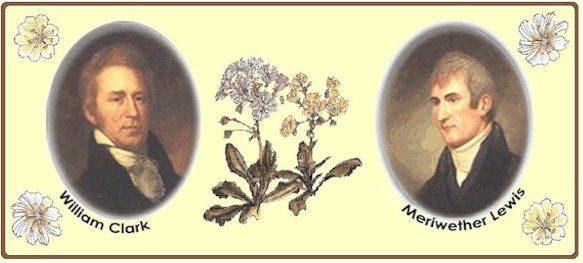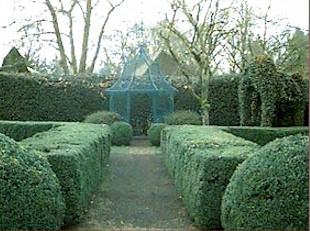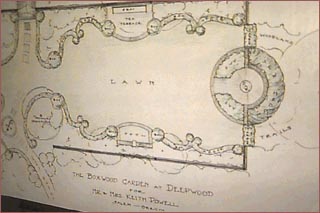WALLACE W HANSEN
Native Plants of the Northwest
Native Plant Nursery & Gardens
2158 Bower Ct S.E., Salem, Oregon 97301 E-Mail:
Wallace W Hansen
PHONE (503)581-2638 FAX(503)581-9957

WALLACE W HANSENNative Plants of the NorthwestNative Plant Nursery & Gardens2158 Bower Ct S.E., Salem, Oregon 97301 E-Mail:
Wallace W Hansen |

|
| Information about Wallace W Hansen Northwest Native Plant Nursery & Gardens: Business Information (Ordering, etc.) | |
Updated July 05, 2005 |
Wallace Hansen Celebrates Lewis and Clark |
|
|

 
|
Botanical Discoveries of the Lewis and Clark ExpeditionRed Alder (Alnus rubra)Cowlitz River in Oregon, March 26, 1806 Used medicinally and as a dye plant by the Native Peoples, Captain Lewis learned of this plant from visitors to the camps. He noted it in his journal on February 9, 1806, calling it a "black alder." All that remain of the specimen he collected on March 26, 1806 somewhere along the lower Columbia River between Puget's Island and the Cowlitz River. He wrote on March 27 that he "saw . . . the growth which resembles the beach." Moulton writing in 1991 believed this meant Alnus rubra. Lewis also stated that "the black alder appears as well on some parts of the hills as the bottoms." On 30 Mar, Lewis mentions that "the black alder common on the coast has now disappeared. This makes sense because today this is a coastal specimen and grows no more than 100 miles inland, from southern Alaska to California in modern day USDA zones 7-10. |
This painting is one of a series of 4 titled Wally's Bird Walk by botanical artist Heidi Hansen (Click on image for large view) |
At this time in 1806: |
|
Relations between the Clatsops and the expedition generally went well
through the duration of the Corps’ stay. The only negative incident
between the two groups – the Expedition’s theft of a Clatsop canoe –
was concealed from the Clatsops.
At the expedition’s departure from Fort Clatsop on March 22, 1806, Lewis wrote in his journal that Coboway “has been much more kind an[d] hospitable to us than any other indian in this neighbourhood.” Because of his friendship with the expedition, Coboway was left Fort Clatsop and all its furniture by Lewis and Clark.
And so the Expedition turns toward home. |
Current events: |
|
|
The Corps of Discovery II Lewis and Clark Traveling Exhibit Beginning it's 4-year tour, stopping at communities along the trail that the Corp of Discovery took during the three years and eight months it took to make their journey. The exhibit will end in Oregon. The exhibit consists of a 53-foot long trailer carrying two tents, a stage, chairs, lighting, sound and visual gear and heating and air-conditioning equipment. One tent will hold an audio tour of replicas of historical paintings depicting the expedition's main characters and the landscapes they saw. Guided and sponsored by the following organizations: Library Associations of Washington D.C., Virginia, West Virginia, Maryland, Pennsylvania, Ohio, Kentucky, Indiana, Illinois, Missouri, Iowa, Kansas, Nebraska, South Dakota, North Dakota, Montana, Idaho and Oregon - which collectively comprise Trail States Library Associations - and the U.S. National Park Service (NPS). |
|
|
|
|
|
Deepwood Estate Museum 1894 Queen Anne Style Home Salem, Oregon Landscape architects Elizabeth Lord and Edith Schryver were commissioned by Alice Brown to create the formal gardens at Deepwood Estate. Lord and Schryver were the first formally trained women landscape architects in the Northwest. Pictured at right, top, is the 1905 Lewis & Clark Gazebo acquired by Mrs. Brown and sited at Deepwood in 1949. Below is an architectural drawing of the grounds at Deepwood. Deepwood is the most significant example of landscape architects Elizabeth Lord and Edith Schryver's Northwest work. It is their only garden design that is open to the public. Intriguing features at Deepwood include a scroll garden with a hidden signature, an ivy tunnel and a pastel tea garden. There are three other superb examples of their designs in the area, but they are associated with private residences.
|

|
|
Visitor Information 1116 Mission Street SE Salem, Oregon 97302
Deepwood grounds open dawn to dusk daily at no charge. Deepwood House Tours are 12:00-5:00 pm. hourly, May thru September, Sunday-Friday; October thru April, Tuesday-Saturday Admission: Adults, $4.00/Students and Seniors, $3.00/Children, $2.00 (under six - free)
http://www.oregonlink.com/deepwood/ House Tour Information: 503-363-1825 |

|
|
|
|
|
PICTURING THE CORPS OF DISCOVERY: The Lewis and Clark Expedition in Oregon Art An exhibit at the State Capitol building Presented by Oregon Historical Society |
|
|
December
20, 2002 through December 2004
State Capital building, 900 Court Street NE, Salem, Oregon 8 a.m. - 5 p.m. Monday - Friday 12 p.m. - 4 p.m. Saturday Closed - Sunday |
|
|
"Picturing
the Corps of Discovery demonstrates how artistic interpretations of the
Lewis and Clark Expedition mirror the history and evolving values of
Americans, and more specifically Oregonians, over the past two centuries.
Viewers will be introduced to works of art with Lewis-and-Clark themes
that reflect changing understandings of topics as diverse as democratic
ideals, ethnicity, and the environment.
A collection of images of Lewis and Clark pointing westward, including Frank Schwarz's treasured 1938 mural in Oregon's Capitol rotunda, demonstrate how the two explorers were credited with introducing civilization to the West well into the first half of the twentieth century. By the end of the century, however, works like Michael Florin Dente's 1988 sculpture, The Naming of Mount Jefferson, at the University of Portland, celebrated the expedition's ethnic mix as a historical precedent for a multicultural, pluralistic society in the West." http://www.ohs.org/exhibits/picturing-the-corp-of-discovery.cfm |
|
|
|
|
Back Issues:To see back issues of Wallace Hansen Celebrates Lewis and Clark, click on this link to jump to the index. |
|
Commemorative Painting by Heidi Hansen:The illustrated map below was created by renowned botanical artist Heidi D. Hansen especially for this website. Done in ink and watercolors, Heidi shows many of the plants Captain Lewis documented overlaid atop a map showing a portion of the journey. (Click on image for large view). |
|
|
|
|
|
|
|
|
|
|
|
|
|
|
Click here to return to my Home Page |
|
Questions about plants, click here: Regular Email to Wally To order, click here: Secure Email to Wally |
|
|
Comments or questions about our web site, click here: Webmaster |